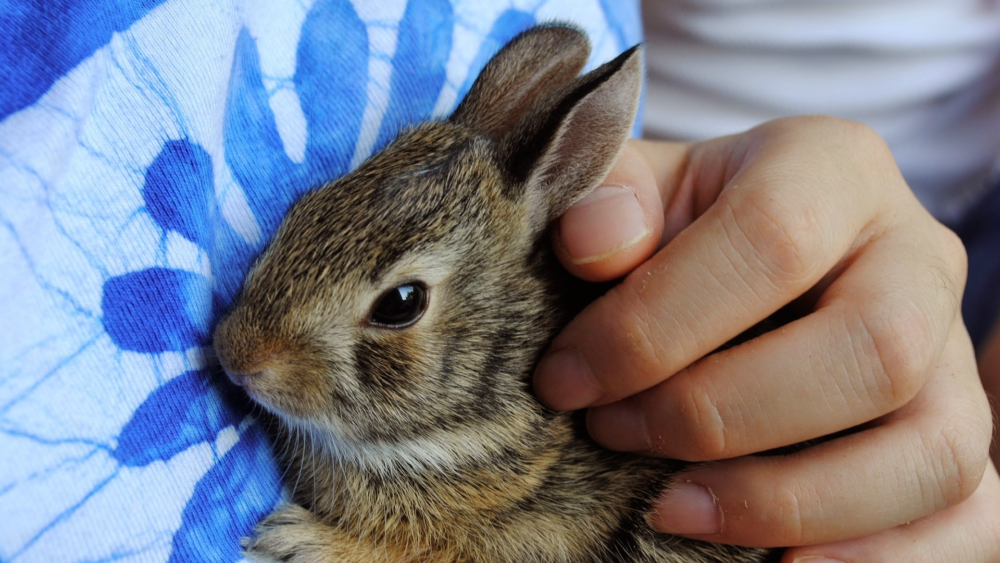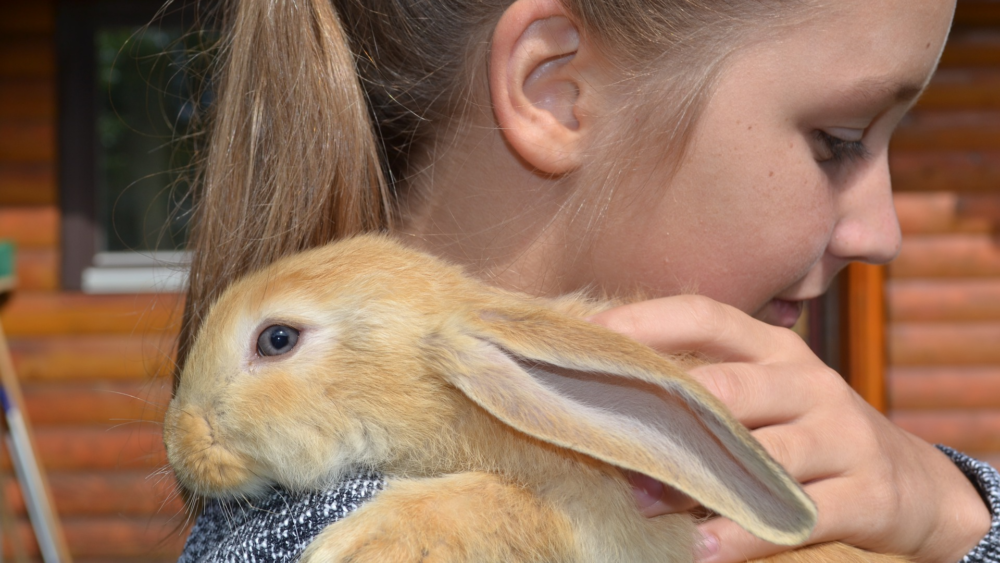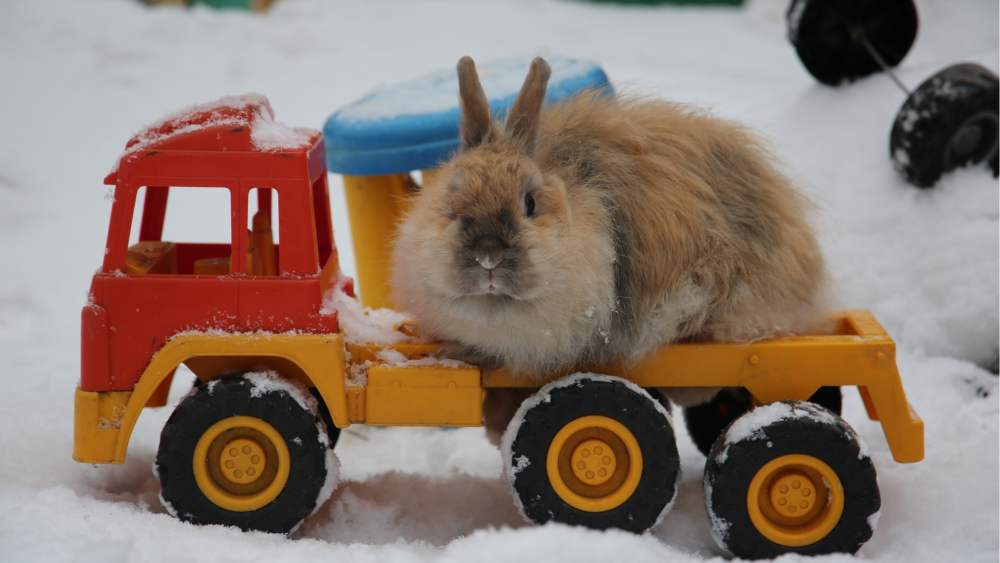When my family and I moved out to our homestead, one of our first animals was a bunny. My kids each chose one. And soon their adventure of bonding with their little rabbits began. My children were unsure how to do this at the beginning.
Luckily, the bunny breeder also had some great advice on how to bond with your rabbit. My children followed her guidance to the letter. Now, we have happy kids and happy rabbits to complete our blissful homestead vision.
Rabbits are surprisingly happy to bond with humans and will seek your company once you bond. You must offer them a good deal as their human friends.
How do you bond with your rabbit? Bond with your rabbit through regular feedings, playful interactions, games, and safely holding your bunny. Stay quietly present around them and allow your rabbit to come to you. Mirror your rabbit’s movements, and encourage them to come to you. Pick them up and cuddle them when they are ready. Spend time with your rabbit.
It sounds easy, but there are a few important aspects to understand
Foundational Rules For Bonding With Your Pet Rabbit
There are many ways to bond with your pet rabbit. The methods my kids used aren’t the only ways, but they are some of the most effective bonding methods. You can pick one or use all of these methods to build a loving relationship with your bunny.
Before you start your bunny bonding, you should prepare correctly to develop this relationship. If your rabbit is wild and not really used to humans, it will take a lot longer. Your rabbit will require much more communication to get them used to your presence. Eventually, you can gain their trust so they will bond with you.
1. Don’t Control Your Rabbit
My kids tried to force their rabbits to sit on their laps when they began socializing with the rabbits. This didn’t work and the two rabbits became frightened and leaped off them each time. This is when we were advised to stop trying to force the rabbits.
Instead, work on letting the rabbits get used to your presence. Introduce yourself to them by mimicking your rabbits’ behavior. This means you need to carefully watch your rabbits. Notice what they do, how they move, what they like to nibble on, and how they interact with each other. You can then pretend to be a rabbit too, making friends with your rabbit. Keep your movements slow and focus on grazing like your rabbit does.
I explained it to my kids like this: if you want to make friends with the new children at school, do you just jump into their group? Nope. You will take some time to watch them, seeing what they like, noting what you have in common with them. When you are ready, you will gently move into the group, giving the other kids time to adjust to you. The same applies to your rabbits.
2. Learn How to Communicate With Your Rabbit
Your next preparation for bonding with your rabbit is to learn how they communicate. Rabbits are surprisingly vocal animals. They have a whole host of sounds and noises they make to communicate, and knowing which means “hey, how’re you doing?” is essential to bonding with your rabbit.
Tooth-clicking
This is a sign that your rabbit is happy. Rabbits often make tooth-clicking sounds after a meal or if they are preparing to snooze in the sun. If your rabbit is clicking their teeth while you are around, it shows they like you being near.
Snorting
This is a complicated sound to interpret, and you should read it with the rabbit’s body language. Snorting can indicate fear if your rabbit is sitting upright and looks tense. If they snort and paw at you, it means they want attention.
Grunting
If your bunny grunts at you, it means “back off.” Your rabbit is not happy to be handled or cuddled if they grunt.
Squealing and Crying Out
If your rabbit cries or squeals, it means they aren’t happy being handled. You may have hurt your rabbit by picking them up incorrectly. Should your rabbit cry out when you approach them, it means they fear you.
Forcing them to be near you will not lead to bonding. Instead, back off and let them come to you when they are calm and used to your presence.
3. Reading Your Rabbit’s Body Language
Your rabbit’s body language can tell you a lot about them. If your rabbit is happy, chances are they will be more content with you joining their fun and bonding. If your is rabbit tense, your presence will only further upset them.
Always remember that rabbits can quickly become stressed, and their immunity may suffer. Stressed rabbits quickly sicken and die.
Read your rabbit’s body. It tells you exactly how your rabbit is feeling at any given time.
Rabbit Ears
Rabbits have very expressive ears. When their ears are relaxed and folded back on their body, they are happy and relaxed. This is a good time to approach your rabbit.
Should their ears be unnaturally perked and listening, your rabbit is tense and fears there may be a predator around.
If your rabbit has one ear forward and one ear relaxed backward, it means they’re alert but not concerned yet. You can approach slowly to not to startle them.
Rabbit Legs
If your rabbit is lying down with its hind legs stretched behind them, your rabbit is relaxed. Thumping indicates they are interested in you or it can show they are unhappy or scared.
Rabbit Body
When your rabbit has a relaxed body, it means they are happy to be handled. A rabbit that tenses when you touch them or draws their hindlegs in when you hold them is stressed.
If your rabbit is happy with your presence, they will lick you or nudge you with their nose. This is affectionate behavior, and it shows the rabbit is happy to have you near.
4. Meet Your Rabbit’s Needs
If you want to bond with your rabbit, make sure you meet their needs. A bunny will love and show affection if you make sure they don’t lack anything. This means your rabbit needs a comfortable hutch or enclosure where they feel safe. Your rabbit needs to have enough food like fresh hay, leafy greens, and roots to eat.
Ensure you have met all of your rabbit’s needs, and their body language and communications tell you that they are ready before you approach. Only then can you begin bonding.
10 Ways to Bond With Your Rabbit
When using the following bonding methods, be sure that you watch your rabbit for signs that they aren’t happy or that they are becoming stressed. If you sense they feel threatened by you, back off and try again later. Never rush—you’re on bunny time now!
1. Meal Times Provide a Way to Nurture Your Rabbit
Food is the way to the heart of many animals, and bunnies are no different. Use meal times to help your bunny get used to your presence. As a bonus, your bunny will begin to associate you with food, which is a nice thing to them. So by extension, you’re nice in bunny language.
To start, you may simply sit outside your rabbit’s cage or enclosure after you have placed new food in for them. Just sit patiently, letting your rabbit get used to you being there.
Over time, decrease the distance between you and the feed area or place the food bowls next to your feet and sit very quietly as your rabbit comes for their meal or snack. Eventually, build up to having the bowl on your legs or even on your lap. Progress to having treats such as yummy carrots in your hands, ready for the brave rabbit to come enjoy.
2. Hold Your Rabbit Right to Help It Feel Safe
Bonding has the ultimate goal of having your rabbit snuggle in your arms, but it doesn’t happen overnight. Physical contact takes time. When your rabbit is ready for you to touch it, begin by simply stroking its back or rubbing its head with a finger. Never presume they are ready to be scooped up. After all, rabbits aren’t like puppies.
To hold your rabbit, pick them up correctly from the start. Remember, your rabbit may be shy and can try to jump out of your arms quickly, so be ready to prevent that. A rabbit has a weak spine, and falling from heights (like your arms) can cause them to become paralyzed.
Pick up your rabbit by gently restraining them with one hand on their spine, before sliding the other hand in under their belly, moving the hand up from between their front legs. Hold your rabbit in this sandwich position. Let your rabbit rest on your forearm, while you hold them securely with the other hand on their spine.
Extend this position by bringing the rabbit to your chest. Gently press their tummy into your stomach as you hold them with one hand resting on their spine and the other under their hind legs. This is known as the heart-to-heart position.
Top Tip: Be careful when picking up your rabbit for the first time. Rabbits have powerful back legs, and they can kick strong enough to break bones. When you have lifted your rabbit into the heart-to-heart position, you may want to use your free hand to support and restrain their back legs.
3. Be Still While Holding Them
This may seem silly. But, holding still and waiting to do activities is the best way to bond with your rabbit. Just let them sit with you and wait patiently. Chill on the sofa while your rabbit explores your lap, smelling you. This is how your rabbit is memorizing you, and they will see you as part of their family unit.
4. Be a Safe Space
Humans are loud and busy creatures. We tend to make noises, talk loudly, and move suddenly. This is not how rabbits behave. Sudden noises and movements are what predators make when they jump from the bush. Your rabbit will not be happy to be near what they associate with a predator.
So become your rabbit’s safe space. Talk quietly, move slowly, and pause often. Giving your rabbit time to adjust to your presence will help them not fear you.
5. Put Your Rabbit Down
While you may believe the goal is to hold your rabbit, you should also make your rabbit feel free by not constantly trying to pick them up and carry them around. This can be hard for children to learn. I certainly had to speak to my own kids about not always picking up their rabbits.
Your rabbits may really appreciate that you don’t always pressure them to be picked up, and instead, you are happy to sit with them while they do their rabbit thing.
6. Train Your Rabbit to Ask
Rabbits are incredibly intelligent. They can learn vocal commands such as “sit” and “jump.” Rabbits can also be taught to use a litter box, which is not a natural activity for them. So, with the aid of a clicker or by learning to cluck your tongue, you can teach your rabbit to ask you when they want to be picked up.
This is a gradual process of teaching your rabbit to accept being first gently pressed with your hands. Next comes sliding your hand under their belly and finally having them raise up their front paws. This is the moment they “ask” to be held. Use a click or a cluck and a treat at each movement as a reward. Your rabbit will learn in no time to ask as this means they get a treat.
7. Explore With Your Rabbit
Rabbits are naturally curious animals, and they usually have access to a much larger area in the wild than what your rabbit pen may offer. Taking your rabbit on walks can be really stimulating for them. Being in a new place can also help your rabbit trust you more.
Start small with this bonding method. Never take your rabbit where they may feel threatened or in areas where there is a lot of activity and noise. A five-minute walk in your backyard can really help your rabbit have fun with you and explore the outside world.
8. Train Your Rabbit for Tricks
Once your rabbit has become more adjusted to being with you, your options will increase on how to bond with them. Rabbits are active creatures, and they love doing athletic activities such as jumping and crawling under things.
You can create a maze where your rabbit can follow a trail of treats to get them through the obstacles. And you can also teach your rabbit to do fun tricks like “sit,” “lie down,” and “play dead.”
The secret to this method of bonding is to break each trick down to the smallest possible steps, reward, and repeat.
9. Buy Your Rabbit Some Toys
Since I was a non-rabbit person before we got our rabbits, I was surprised to learn that rabbits love toys, just like dogs do. Rabbits will play with balls, carry around twisted rope toys, and they will even explore 3D puzzles that hide treats.
Whichever toys you place in your rabbit’s enclosure, be sure they are rabbit-friendly. Never give your rabbit a toy designed for a dog or cat before checking with your vet whether it is safe for your rabbit to enjoy.
Toys are made to share, and you can happily play with your rabbit with a great toy such as a pull toy or even a stuffed animal or two. Find out what is your rabbit’s favorite toy, and use it to engage with your rabbit.
10. Groom and Look After Your Rabbit
Rabbits often engage in mutual grooming. If your rabbit doesn’t have another rabbit buddy, you will have to step up and take over grooming duties. Invest in some great rabbit-friendly brushes to groom your rabbit. Clean your rabbit regularly with wet wipes or cornstarch powder.
If you have two or more rabbits, it is a great idea to have them spayed or neutered. This will prevent unwanted pregnancies, and you will also ensure a longer life span. Unneutered rabbits tend to fight often, which can place your rabbit’s health in jeopardy.
A rabbit buck or doe that has been spayed or neutered will be much more docile and less likely to kick or bite. This will make the bonding process much easier.
Conclusion
Rabbits are great pets, and whether you live on your own land or in the city, you can keep rabbits and bond with them. Be sure to really consider what your rabbit wants, take care of their physical and emotional needs, and stimulate them.
When you have bonded with your rabbit, you will find that your rabbit will seek you out and want to spend time with you. This is how you earn a friendship for life.
Recommended Rabbit Supplies
This list contains affiliate products. Affiliate products do not cost more but helps to support BestFarmAnimals and our goal to provide farm animal owners with accurate and helpful information.
Housing: If your rabbit is indoor, you’ll need a cage, a hideout (to keep your rabbit from death by heart attack), and a space for it to get exercise and spend time with you. If you don’t want to let it run free in your house, this animal playpen provides space and keeps your rabbit from hiding under your couch.
If you keep your rabbit outdoors, an outdoor hutch that provides space and protection from predators is needed. (I’d still keep mine in a barn for further protection from the elements.)
You’ll also need bedding, toys, a grooming brush, and treats for your little friend. A litter box is important because rabbits can be potty trained. Timothy hay is the best kind of hay for rabbits as alfalfa is too sweet. Don’t forget a water drinker. I like the half-gallon waterer because it can cover two rabbits for several days. Pair it with a food bowl or a food manger (a little cleaner) and you’ll be set up!
If you want to treat your bunny to entertainment, a cat tower, a treat ball, or bunny toys all work wonderfully.
Finally, if you plan on taking your rabbit with you on trips, you’ll need a carrier. Here’s a small carrier or larger carrier that work great for occasional travel. If you travel a lot, you might want the carrier that’s rated #1 in safety for safe travels
Lastly, I use this odor eliminator for accidents and to wipe out the bottom of the cage and litter box when I clean it.



